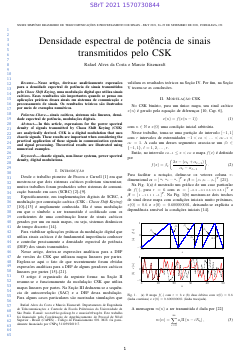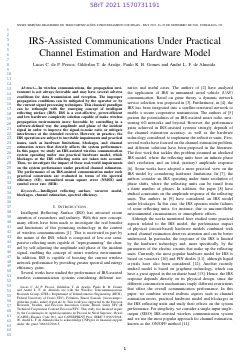
XXXIX Simpósio Brasileiro de Telecomunicações e Processamento de Sinais

Densidade espectral de potência de sinais transmitidos pelo CSK
Rafael Alves da Costa, Marcio Eisencraft
DOI: 10.14209/sbrt.2021.1570730844
Keywords:
Abstract
In this article, expressions for the power spectral density of signals transmitted by Chaos Shift Keying (CSK) are analytically derived. CSK is a digital modulation that uses chaotic signals. These results are important when considering the practical application of signals in communication systems and signal processing. Theoretical results are illustrated by means of numerical examples.Download

Impacto de SIC imperfeito em sistemas WPCN-NOMA com garantias de QoS
Hugo Victor Bezerra Aragão, Pedro Castro, Cibelly A. A. Lima, Francisco Rafael Marques Lima, Jhenifer de Oliveira Melo
DOI: 10.14209/sbrt.2021.1570730905
Keywords: Comunicação em redes sem fio Acesso Múltiplo Não-Ortogonal SIC imperfeito Fator de Erro Residual
Abstract
Redes de comunicações energizadas através de meios sem-fio ou, do inglês, Wireless Powered Communication Network (WPCN), consistem em um novo paradigma em que dispositivos móveis podem ser energizados através de ondas rádio em uma primeira fase, relaxando assim a necessidade de trocas de baterias. Posteriormente, em uma segunda fase, estes mesmos dispositivos transmitem informações para um ponto de acesso. Neste estudo, assumimos que o acesso múltiplo não-ortogonal ou, do inglês, Non-Orthogonal Multiple Access (NOMA), é aplicado na segunda fase de forma a prover ganhos de eficiência espectral quando comparado aos outros esquemas de múltiplo acesso ortogonal. Contudo, assumimos que o cancelamento sucessivo de interferência ou, do inglês, Successive Interference Cancellation (SIC), realizado no receptor é imperfeito. O objetivo deste estudo é avaliar o impacto do SIC imperfeito no desempenho de um sistema WPCN com garantias de qualidade de serviço ou, do inglês, Quality of Service (QoS), em que a duração das fases 1 e 2, assim como a ordem de decodificação SIC são otimizadas. Resultados de simulação demonstram que o grau de imperfeição de SIC possui um grande impacto na taxa de dados assim como na garantia de QoS.Download

Sistema Integrado para Cancelamento de Realimentação e Redução do Efeito de Oclusão em Aparelhos Auditivos
Renata Coelho Borges, Marcio H Costa
DOI: 10.14209/sbrt.2021.1570730909
Keywords: aparelho auditivo realimentação efeito de oclusão
Abstract
This work presents a joint strategy for feedback canceling and reduction of the occlusion-effect in hearing aids. Positive feedback and the occlusion-effect are undesired phenomena, in which, in general, efforts for attenuation of one correspond to amplification of the other. To avoid this antagonism, an active approach based on the Least Mean Square algorithm with updates in the frequency domain is proposed; in which, the occlusion effect is handled in low frequencies, while the feedback is treated in high frequencies. Computational simulations and psychoacoustic assessment with volunteers support the efficiency of the proposed method.Download

Avaliação do desempenho de técnicas de estimação espectral em interfaces cérebro-computador
Erick Monteiro, Rafael Ferrari
DOI: 10.14209/sbrt.2021.1570730947
Keywords: SSVEP estimação espectral seleção de atributos
Abstract
Interfaces cérebro-computador (BCI) são sistemas que, ao interpretar a atividade cerebral, fornecem um meio de comunicação alternativo, possibilitando diversas aplicações, principalmente para reabilitação. Nesse estudo, foi realizada uma avaliação de diferentes técnicas de estimação espectral aplicadas à extração de características para BCI no paradigma de Potenciais Evocados Visualmente em Regime Estacionário (SSVEP). Os resultados mostram que, embora não haja uma técnica que se sobressaia decisivamente para o conjunto de dados utilizado, algumas podem ser mais robustas em relação ao método de seleção de características e ao tamanho da janela de estimação.Download

Change Detection Algorithm Based on U-NET Convolutional Neural Network for Multitemporal Wavelength-Resolution SAR Images
Rodrigo A Santos, Marcelo S. Pinho, Renato Machado
DOI: 10.14209/sbrt.2021.1570731149
Keywords: CDA CNN SAR Images Textures
Abstract
This paper presents a change detection algorithm (CDA) for multitemporal wavelength-resolution synthetic aperture radar (SAR) images based on U-NET convolutional neural network (CNN) architecture. The algorithm uses non-linear filtering to extract textural information from amplitude SAR images. Since we want to detect changes in multitemporal acquisitions, relevant textures (entropy and variance) can be obtained from the histograms of sum and difference SAR images. The original images and the obtained textures are given as input of the proposed algorithm. As a result, the proposed CDA has a similar detection performance compared to other methods, but the number of false alarms is significantly reduced.Download

Music Processing Experiment with Python Notebook and IoT App
Felipe Almeida, Victor Takashi Hayashi
DOI: 10.14209/sbrt.2021.1570731183
Keywords: Audio Signal Processing Education IoT Cloud
Abstract
Providing active learning in signal processing is a relevant educational challenge. Open Educational Resources (OER) might foster practical activities that assist in student learning. In this article, a music processing experiment in a Python Notebook with local and cloud execution alternatives is presented to complement the theoretical education in signal processing. The open-source experiment is also connected to a cloud IoT platform to foster external integrations in students' projects, and activities are organized according to Learning Objectives according to Bloom's Taxonomy.Download

IRS-Assisted Communications Under Practical Channel Estimation and Hardware Model
Lucas Campos de Paula Pessoa, Gilderlan Tavares de Araújo, Paulo R. B. Gomes, André de Almeida
DOI: 10.14209/sbrt.2021.1570731191
Keywords: Intelligent reflecting surface Varactor model Blockages Channel estimation
Abstract
In wireless communications, the propagation environment is not always favorable and may have several adverse conditions for data transmission and reception. The improper propagation conditions can be mitigated by the operator or by the current signal processing techniques. This classical paradigm can be rethought with the emerging concept of intelligent reflecting surface (IRS). IRS is a cost-effective, power-efficient and low hardware complexity solution capable of making wireless propagation environments more favorable by controlling in a software-defined way the amplitude and phase of the incident signal in order to improve the signal-to-noise ratio or mitigate interference at the intended receiver. However, in practice, the IRS operation are subject to inevitable impairments and practical issues such as hardware limitations, blockages, and channel estimation errors that directly affect the system performance. In this paper, we study an IRS-assisted wireless communication system operating under practical hardware model in which blockages at the IRS reflecting units are taken into account. Then, we investigate the impact of these real-world impairments on the system performance under practical channel estimation. The performance of an IRS-assisted communication under such practical constraints are evaluated in terms of the spectral efficiency (SE), normalized mean square error (NMSE) and symbol error rate (SER).Download

Vehicle Platooning System with Tensor-based Space-Time Coding Schemes
Bárbara Oliveira, Michel dos Santos, Walter da Cruz Freitas Jr.
DOI: 10.14209/sbrt.2021.1570731199
Keywords: Platooning TST KRST KronST
Abstract
In this article, we discuss the platooning system and propose models for its implementation based on multilinear algebra. It is investigated a model with Khatri-Rao Space-Time (KRST) coding and another model that combine a Tensor Space-Time (TST) and Kronecker Space-Time (KronST) codings, using Parallel Factor Analysis (PARAFAC) and Tucker decompositions. A performance analysis is carried out to illustrate and compare the efficiency of the presented algorithms.Download

The Shannon and Rényi Differential Entropies of the Weighted Sum of Squared Nakagami-m Random Variables
Antônio Alisson Pessoa Guimarães, Charles Casimiro Cavalcante
DOI: 10.14209/sbrt.2021.1570731409
Keywords: Shannon differential entropy Rényi differential entropy Nakagami-m random variable
Abstract
This paper investigates the Shannon and Rényi differential entropies over the weighted sum of squared Nakagami-m mutually independent random variables. Based on the probability density function (PDF) of the sum of Gamma variables, we provide, in terms of special functions, simple closed-form expressions for such entropy measures. Here, we also present the numerical results of a particular case involving the weighted sum of two squared Nakagami-m random variables, in order to graphically represent the theoretical analysis. Finally, we hope that this work will be a useful reference in wireless communication systems over Nakagami-m fading channels.Download

Eficiência Espectral e Atraso em Comunicação Full-Duplex Device-to-Device Bidirecional
Rhenan Bezerra da Silva, Paulo Cardieri
DOI: 10.14209/sbrt.2021.1570731444
Keywords: Comunicação sem fio Device-to-Device Full-duplex Geometria Estocástica
Abstract
A comunicação bidirecional simultânea por meio da técnica full-duplex (FD) permite que o tráfego escoe mais rapidamente em um enlace, diminuindo o acesso ao canal pelo enlace, reduzindo assim a interferência em uma rede. Por outro lado, a comunicação FD causa o aumento na interferência pelo aumento do número de transmissões. Nesse trabalho, investigamos o resultado final desses dois efeitos na capacidade agregada de enlaces D2D operando em uma rede celular. Modelando o enlace D2D como dois sistemas fila+servidor, mostramos que o uso da técnica FD aumenta a eficiência espectral por unidade de área da rede, às custas de um aumento no atraso e, consequentemente, redução da região de estabilidade dos enlaces.Download